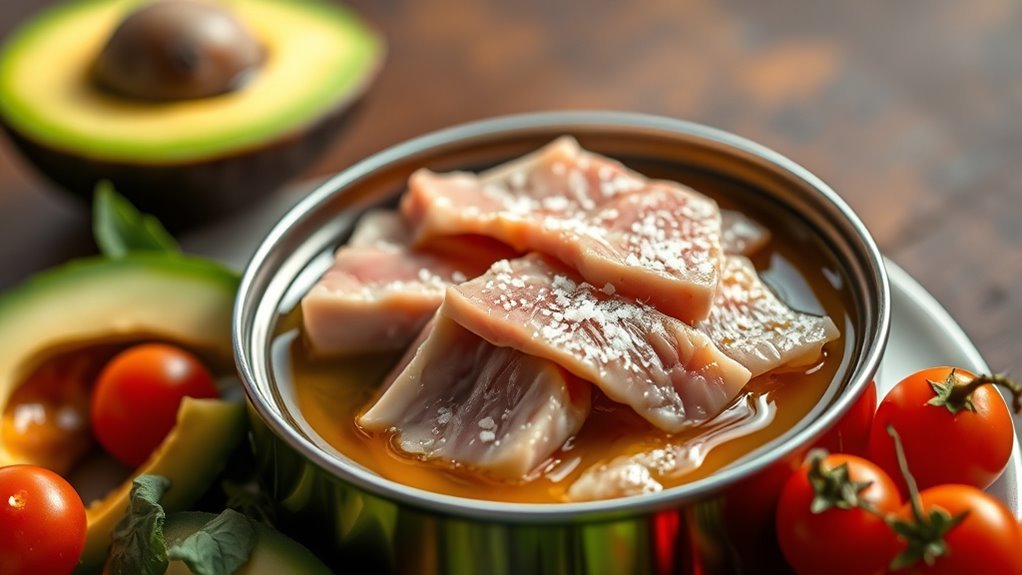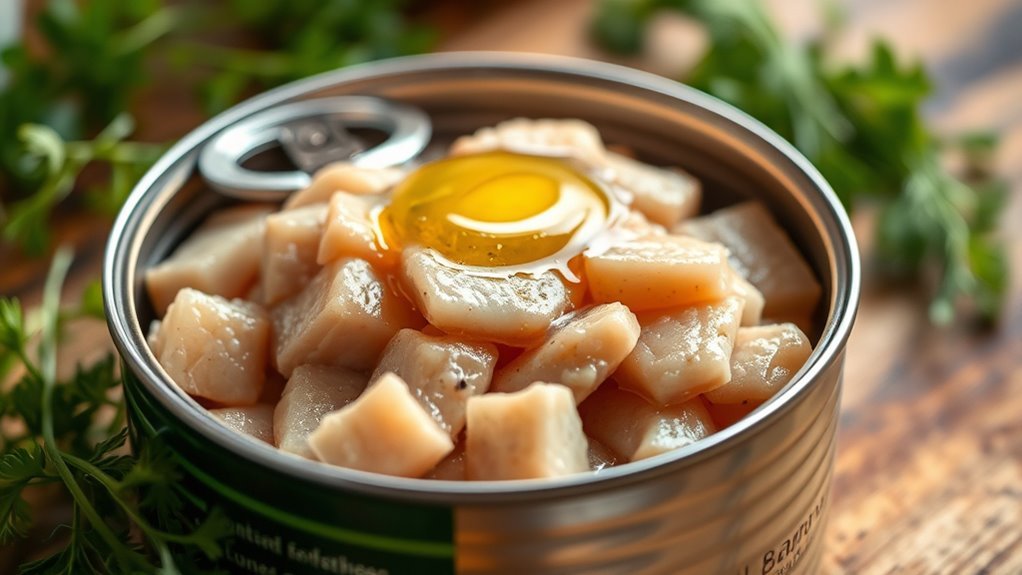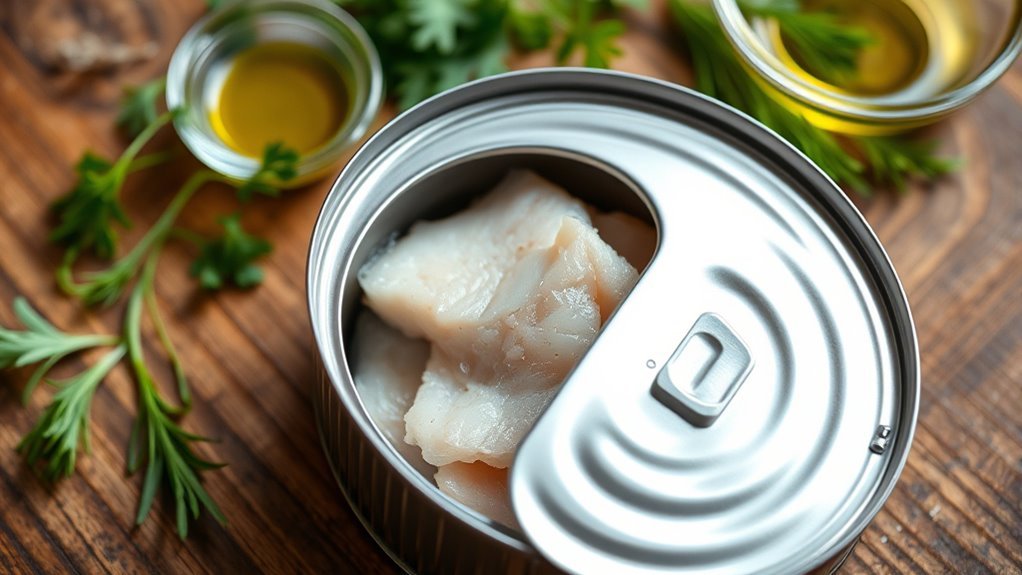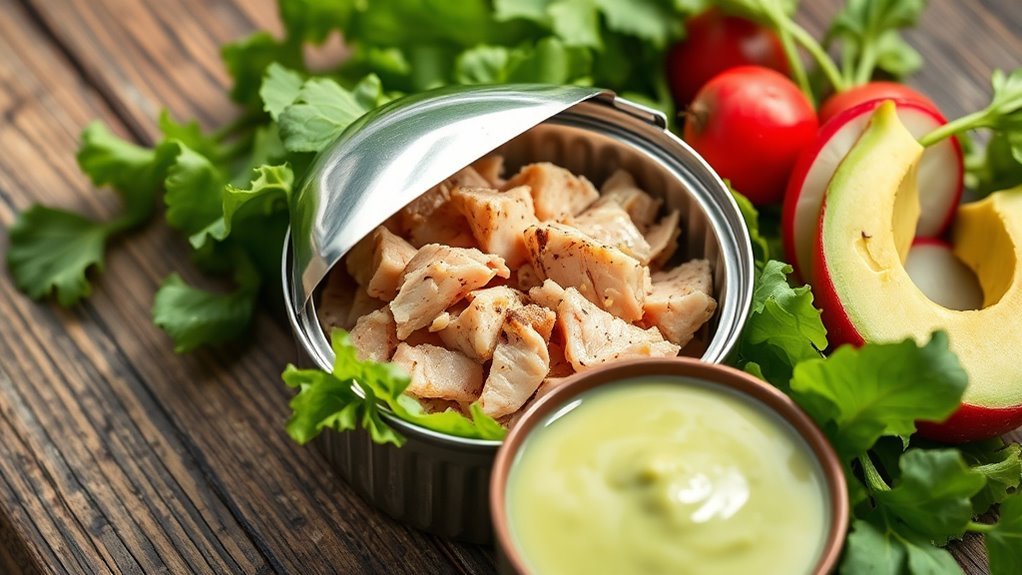Yes, canned tuna is keto-friendly! It packs about 20 grams of high-quality protein per serving and has zero carbohydrates, making it perfect for low-carb diets. Loaded with omega-3 fatty acids, it also supports heart health and reduces inflammation. Canned tuna is versatile and easy to incorporate into meals, from salads to casseroles. Just be sure to check the labels for added ingredients. Want to discover creative meal ideas and choose the best options? Keep exploring!
Nutritional Profile of Canned Tuna

When considering the nutritional profile of canned tuna, one can appreciate its impressive array of benefits. It’s packed with high-quality protein, boasting around 20 grams per serving. This makes it an excellent choice for those looking to build muscle or maintain a healthy weight. Additionally, canned tuna is rich in omega-3 fatty acids, which offer numerous health benefits. These omega-3s support heart health, reduce inflammation, and can even enhance brain function. Incorporating canned tuna into your diet not only provides essential nutrients but also helps you feel satiated longer. With its convenience and versatility, you can enjoy this nutrient-dense option without compromising on taste. So, you can feel good about adding canned tuna to your meals.
Carb Content and Keto Compatibility

Canned tuna is a fantastic option for those following a ketogenic diet, as it contains minimal carbohydrates. With an impressive carb count of zero grams per serving, it’s perfect for maintaining ketosis. This means you can enjoy the rich protein and healthy fats found in tuna without worrying about exceeding your daily carb limits. The keto diet emphasizes low-carb, high-fat foods, making canned tuna a compatible choice that fits seamlessly into your meal planning. Whether you’re adding it to salads, wraps, or enjoying it straight from the can, you can savor it without guilt. Just remember to check labels for any added ingredients that might sneak in carbs, ensuring your keto journey remains on track. Additionally, canned tuna is versatile and can be combined with healthy fats to enhance flavor and nutritional value.
Health Benefits of Canned Tuna

For those committed to a ketogenic lifestyle, canned tuna not only meets low-carb requirements but also offers numerous health benefits. This convenient protein source is rich in omega-3 fatty acids, which can support heart health and reduce inflammation. Additionally, canned tuna is packed with essential nutrients like vitamin D and selenium, promoting immune function and bone health. Its high protein content can help you feel full longer, making it easier to manage cravings while on a keto diet. Plus, the convenience of canned tuna allows you to enjoy these health advantages without extensive meal prep. Incorporating canned tuna into your diet guarantees you’re fueling your body with crucial nutrients while staying true to your keto goals. Moreover, canned tuna is a great source of high-quality protein, which aligns perfectly with the protein guidelines of the keto diet.
Incorporating Canned Tuna Into Keto Meals
While incorporating canned tuna into your keto meals may seem straightforward, it can truly elevate your culinary experience. With its high protein and low-carb profile, tuna is versatile for various meal ideas and recipe variations. Here are some ways to make the most of it:
| Meal Idea | Recipe Variation | Serving Suggestion |
|---|---|---|
| Tuna Salad | Avocado Tuna Salad | Serve on lettuce wraps |
| Tuna Casserole | Cheesy Tuna Zucchini Bake | Pair with a side salad |
| Tuna Stuffed Peppers | Spicy Tuna-Stuffed Bell Peppers | Drizzle with olive oil |
| Tuna Lettuce Cups | Asian-Inspired Tuna Lettuce Wraps | Garnish with sesame seeds |
Experimenting with these options can make your keto journey both satisfying and flavorful!
Tips for Choosing the Best Canned Tuna
When you’re choosing the best canned tuna, it’s essential to take into account several factors to guarantee you’re getting a quality product. First, look for canned varieties packed in water or olive oil, as these options tend to have fewer additives. Check the label for the type of tuna; skipjack or light tuna usually contains lower mercury levels than albacore. Don’t forget to compare tuna brands; some prioritize sustainability and use pole-and-line fishing methods, which is better for the environment. Additionally, consider the sodium content, especially if you’re watching your intake. By keeping these factors in mind, you’ll make a more informed choice and enjoy the many benefits of canned tuna while aligning with your dietary preferences.
Frequently Asked Questions
Can Canned Tuna Be Eaten Daily on a Keto Diet?
Yes, you can eat canned tuna daily on a keto diet. Its high protein and low carbohydrate content makes it a great fit. Plus, it offers nutritional benefits like omega-3 fatty acids and essential vitamins. However, be mindful of your daily intake to avoid excessive mercury exposure, which can be harmful over time. Balancing your diet with a variety of foods will keep your meals interesting and nutritious while still enjoying tuna regularly.
Are There Any Risks Associated With Consuming Canned Tuna?
Yes, there are risks associated with consuming canned tuna, mainly due to mercury levels. While it offers nutritional benefits like protein and omega-3 fatty acids, high mercury exposure can lead to health issues over time. You should balance your intake with other protein sources to minimize risks. It’s important to stay informed about the type of tuna you’re consuming, as some varieties have higher mercury levels than others. Moderation is key!
What Types of Canned Tuna Are Best for Keto?
When choosing canned tuna for keto, look for varieties like albacore or skipjack packed in water or olive oil. These options are low in carbs and high in protein, making them perfect for your keto meal ideas. Avoid those with added sugars or fillers. Combine tuna with avocado or leafy greens for a satisfying salad, or mix it with cream cheese for a delicious dip. Enjoy the freedom to create tasty, keto-friendly dishes!
Does Canned Tuna Contain Added Sugars or Fillers?
Canned tuna’s like a treasure chest; you’ve got to check the locks. Most brands don’t add sugars or fillers, but that’s why ingredient labels are essential. They reveal the nutritional value, showing you exactly what you’re eating. Some flavored varieties might sneak in unwanted additives, so always read carefully. By doing so, you’re ensuring your diet remains clean and focused, giving you the freedom to enjoy your meals without guilt.
How Should Canned Tuna Be Stored After Opening?
After opening, you should store canned tuna in an airtight container in the refrigerator. This guarantees proper storage and helps maintain its quality. It’s best to consume it within 3 to 4 days for ideal shelf life. If you plan to use it later, consider freezing it; however, the texture may change once thawed. Following these guidelines lets you enjoy your tuna while keeping it safe and tasty!


